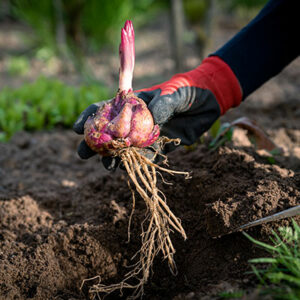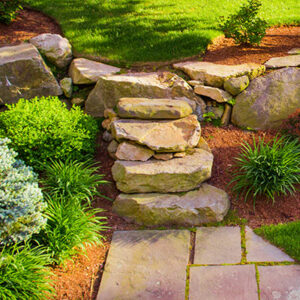Five Ideas to Extend Your PA Gardening Season Well Into the Fall
As fall slowly starts to move in here in Lancaster and the days get shorter and the nights get colder, you probably think your days of gardening are numbered. But avid gardeners know that is not the case. Cooler temperatures are actually easier on plants, while the soil is still warm enough to allow roots to grow until the ground freezes. Below the ground level, roots are growing, microbes and earthworms are doing their work, and things are still biologically alive. While there is typically more rainfall during autumn, the more moderate temperatures mean it’s easier to keep your plants hydrated, and pests are starting to retreat and get ready for hibernation.
If that isn’t enough to convince you, check out the bargain deals you can get on plants at garden centers trying to get rid of inventory before winter. Look for deals on spring-blooming bulbs, perennials, and trees and shrubs. So, what are the best type of plants to seed this time of year? Showcase Lawn Works has the answers. Here are five plants you can and should be planting this fall for optimal growth.
Bulbs

As long as your soil temperatures are still above 50 degrees, fall makes the perfect time to plant bulbs for flowers that bloom in spring and summer. Many bulbs come in a wide variety of colors, heights, and bloom times, so you can determine what works best in your garden. Some of the most common include tulips, daffodils, alliums, crocus, and lilies. If rabbits or deer are a problem, they don’t like plant bulbs such as daffodils, hyacinths, and alliums.
To make sure bulbs perform well, plant them where they will receive plenty of sun. Most bulbs should be planted two to three times as deep as the diameter of the bulb. Place the bulb in the hole pointy side up. Leave the foliage in place until it dies so the bulb can use it as food for next spring’s blooms.
Pansies and Violets
Fall is an excellent time to plant pansies and violets because the soil is still warm enough to give their roots time to grow. They are one of the five most frost-resistant and cold-tolerant flowers. Plus, planting in the fall will allow you to get more overall bloom time because they will begin to fade out in the summer when the temperatures get too hot. Pansies planted in August or September will bloom and last throughout winter and spring. Flowering usually starts in early March. To help them overwinter, add a thick layer of mulch around them once your ground has frozen. Though they prefer the sun, they will grow in partial shade.
Vegetables
Just because it’s fall doesn’t mean growing vegetables is over. If you begin now through September, you can extend your harvest season well into late fall, maybe even winter. A few of the best vegetables to grow in the fall include beets, carrots, onions, broccoli, asparagus, salad greens, and garlic. The hardiest fall vegetables are spinach and kale, which can grow into winter. When it comes to growing veggies in the fall, you’ll want to start by using seeds. Plant them a little deeper than you would in the spring, and be sure to keep them well-watered, about an inch of water per week. You can extend your growing season later in the fall by covering your garden with an old sheet or blanket if frost is in the forecast. If done correctly, you can have fresh veggies from your own garden added to your dinner table this Thanksgiving!
Cool-Season Grasses
Cool-season grasses such as Kentucky bluegrass, perennial ryegrass, fescue, and bentgrass thrive in the fall, whether you’re planting seed or sod. In fact, fall is the best time to plant cool-season grasses. The combination of cool evenings, moderate temperatures, and warm sun enable the seeds to germinate faster, providing you with a rich, fuller lawn. There are also fewer weeds for the seeds to compete with during the fall, giving them a better chance of survival. Showcase Lawn Works offers both seeding and sod installation services to help you get the beautiful grass you desire.
Trees and Shrubs
 Roots can grow in soil as cold as 40 degrees, and soil remains warm long after the air temperature drops. In Lancaster and the surrounding areas, roots can usually grow through December, but you need to plant trees and shrubs six to eight weeks before then, which means now through October. A few trees and shrubs that make for great growth in the fall include:
Roots can grow in soil as cold as 40 degrees, and soil remains warm long after the air temperature drops. In Lancaster and the surrounding areas, roots can usually grow through December, but you need to plant trees and shrubs six to eight weeks before then, which means now through October. A few trees and shrubs that make for great growth in the fall include:
- Knock Out Roses
- Laurel
- Burning Bush
- Forsythia
- Hydrangea
- Elderberry
- Alder
- Ash
- Buckeye
- Catalpa
- Hawthorn
- Honey Locust
- Linden
- Maple
- Sycamore
For All Your Landscaping and Lawn Care Needs, Call on the Professionals at Showcase Lawn Works
Need help with your landscaping? Call on the professionals at Showcase Lawn Works. Serving Lancaster, Chester, and Berks Counties, Showcase Lawn Works specializes in lawn care, tree and shrub care, pest control, and landscaping. Our landscape design team can help you determine which plants and ornamentals work best for you and then handle the design, layout, and planting.
We also offer a high-quality tree and shrub care program to help you with the ongoing maintenance of these beloved plants. Our tree and shrub care program consists of six visits, offering fertilization, insect, and disease control throughout the growing season. As a secondary option, we offer deep-root fertilization, dormant oil applications, and winter burn treatments. Learn more about these programs by visiting our website, requesting a free estimate online, or giving us a call at 717-354-3226. We can’t wait to hear from you.
Did you enjoy the tips we shared above? Great! Check out our other blog articles and stay tuned for next month’s informative piece. And don’t forget to check us out on Facebook.